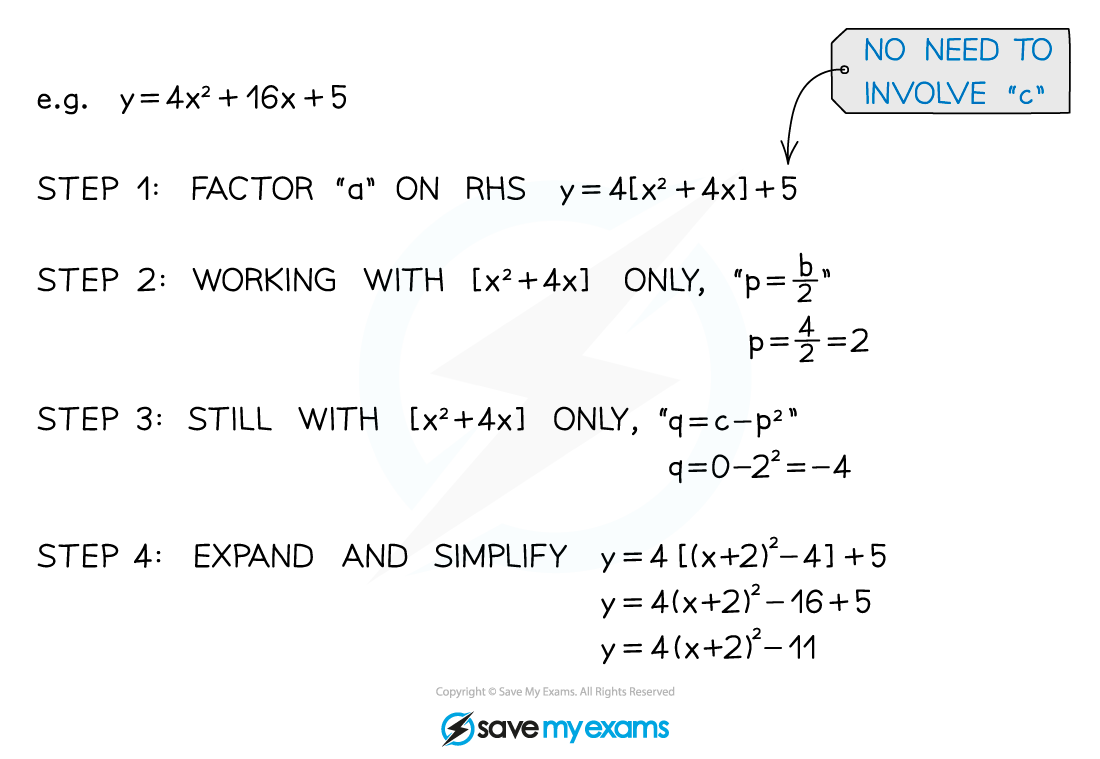Completing the Square (Cambridge (CIE) O Level Additional Maths) : Revision Note
Completing the Square
What is completing the square?
Completing the square is another way of writing a quadratic function
It means rewriting
in the form
The key point is that
now only occurs once in the equation
It can be used to solve quadratic equations, sketch their graphs and to find the coordinates of the turning point
How do I complete the square?
The method used will depend on the value of the coefficient of the term in
When
is half of
is

When a ≠ 1
First take a factor of
out of the
and
terms
Then continue as above

Examiner Tips and Tricks
Sometimes a question will explicitly use the phrase complete the square
Sometimes a question will use the form
without using the phrase completing the square
Worked Example
Write in the form
, where
and
are constants to be found, and
is an unknown constant.
The form required is 'completing the square' (do not be put off by the , it is just a constant!).
STEP 1 - Take a factor of 3 out of the and
terms - leaving
avoids awkward fractions.
STEPS 2 and 3 - Complete the square on the part only. "
" and "
".
STEP 4 - Expand and simplify.
i.e.
Solving by Completing the Square
How do I solve a quadratic equation by completing the square?
To solve x2 + bx + c = 0
replace the first two terms, x2 + bx, with (x + p)2 - p2 where p is half of b
this is called completing the square
x2 + bx + c = 0 becomes
(x + p)2 - p2 + c = 0 where p is half of b
rearrange this equation to make x the subject (using ±√)
For example, solve x2 + 10x + 9 = 0 by completing the square
x2 + 10x becomes (x + 5)2 - 52
so x2 + 10x + 9 = 0 becomes (x + 5)2 - 52 + 9 = 0
make x the subject (using ±√)
(x + 5)2 - 25 + 9 = 0
(x + 5)2 = 16
x + 5 = ±√16
x = ±4 - 5
x = -1 or x = -9
If the equation is ax2 + bx + c = 0 with a number in front of x2, then divide both sides by a first, before completing the square
Examiner Tips and Tricks
When making x the subject to find the solutions at the end, don't expand the squared brackets back out again!
Remember to use ±√ to get two solutions
Worked Example
Solve by completing the square.
Divide both sides by 2 to make the quadratic start with x2
Halve the middle number, -4, to get -2
Replace the first two terms, x2 - 4x, with (x - 2)2 - (-2)2
Simplify the numbers
Add 16 to both sides
Square root both sides
Include the ± sign to get two solutions
Add 2 to both sides
Work out each solution separately
x = 6 or x = -2

You've read 0 of your 5 free revision notes this week
Sign up now. It’s free!
Did this page help you?